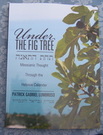For our sake he made him to be sin who knew no sin, so that in him we might become
the righteousness of God.
Reading much differently from its English processed translations, the original Hebrew text of the second verse of the first chapter of the Book of Leviticus presents interesting messianic insights. I do not believe that the English misreading is due to any conspiratory voluntary malefic action, but rather to a reading with an already established theology. We must also realize that a translation always carries the bias of the translator; it is merely a commentary in another language. I heard it said one time that reading the Bible through a translation is like kissing a bride through a veil!
The usual translations of the verse read something to the effect of: “When any one of you brings an offering to ADONAI … (Lev. 1:2), but a more literal translation of the text would read, (my translation) “When a man from among you (you: 2nd person plural) desires to come near Me with n offering …” The word for ‘man’ is adam אדם, the same as the name of the first man Adam. This did not pass the attention of Chassidic teacher Rabbi Schneur Zalman. In 1812 The Rabbi suggested a deeper meaning in the verse; he came to the messianic conclusion of the existence of a supernatural/spiritual Adam who approaches Hashem on the behalf of Israel. Based on the vision of Ezekiel in which he saw ‘a figure with the appearance of an Adam, Jewish teachings sometime offer the idea of a heavenly Adam; it is to this spiritual Adam the Rabbi refers to.
This may sound far-fetched, but only until we read Paul teaching along the same lines in. The Apostle says, "The first man was from the earth, a man of dust; the second man is from heaven" (1 Cor. 15:47). Understanding that everything on earth was created after an heavenly pattern, we understand that Paul’s accounting of first and second does not refer to importance, but only to the chronology of this Adam’s earthly manifestations.
The Rabbi was right. Israel does have an Adam, who approaches Hashem on our behalf, and who "lives to make intercession for them" (Heb. 7:25 referring to Isaiah 53:12). He is our burnt offering in Hebrew called olah עולה or ‘he that ascends’, an image of a total submission and consumption in God and ascending to him (Lev. 1:3; Matt. 26:39; John 3:13-15). He is our grain offering (Lev. 2:2; Matt. 26:26); our peace offering which is an image of communion and fellowship with Hashem through a meal (Lev. 3:1; John 14:27; Rev. 19:9). He also is our sin offering for involuntary sins (Lev. 4:2; 2 Cor. 5:21 (the word for sin in Hebrew or Greek also means: sin offering); Heb. 9:28); and our guilt offering ((Lev. 5:19; Isa. 53: 10-11).
In studying the eternal offering ordinances in the Book of Leviticus, we learn about Yeshua’s eternal intercessory role in our lives. It is one and the same thing, and since He completes them (Matthew 5:17), if the offerings become obsolete as some teach, Yeshua also becomes obsolete, God forbid!
May we always be granted to confidently approach Hashem through him who is our eternal intercessory offering, in a spirit of submission and humility, in full knowledge of our sin, and personal unworthiness.
 RSS Feed
RSS Feed


